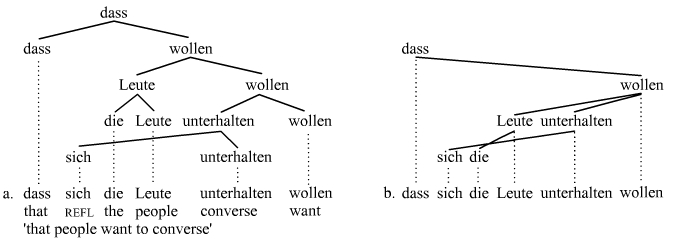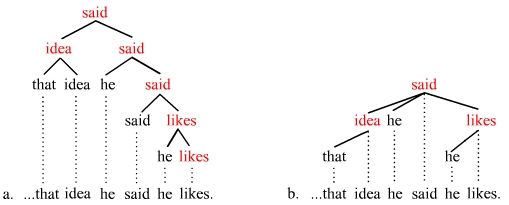In linguistics, syntax is the study of how words and morphemes combine to form larger units such as phrases and sentences. Central concerns of syntax include word order, grammatical relations, hierarchical sentence structure (constituency), agreement, the nature of crosslinguistic variation, and the relationship between form and meaning (semantics). There are numerous approaches to syntax that differ in their central assumptions and goals.
In linguistics, a verb phrase (VP) is a syntactic unit composed of a verb and its arguments except the subject of an independent clause or coordinate clause. Thus, in the sentence A fat man quickly put the money into the box, the words quickly put the money into the box constitute a verb phrase; it consists of the verb put and its arguments, but not the subject a fat man. A verb phrase is similar to what is considered a predicate in traditional grammars.
In linguistics, a determiner phrase (DP) is a type of phrase headed by a determiner such as many. Controversially, many approaches, take a phrase like not very many apples to be a DP, headed, in this case, by the determiner many. This is called the DP analysis or the DP hypothesis. Others reject this analysis in favor of the more traditional NP analysis where apples would be the head of the phrase in which the DP not very many is merely a dependent. Thus, there are competing analyses concerning heads and dependents in nominal groups. The DP analysis developed in the late 1970s and early 1980s, and it is the majority view in generative grammar today.
A movement paradox is a phenomenon of grammar that challenges the transformational approach to syntax. The importance of movement paradoxes is emphasized by those theories of syntax that reject movement, i.e. the notion that discontinuities in syntax are explained by the movement of constituents.
Dependency grammar (DG) is a class of modern grammatical theories that are all based on the dependency relation and that can be traced back primarily to the work of Lucien Tesnière. Dependency is the notion that linguistic units, e.g. words, are connected to each other by directed links. The (finite) verb is taken to be the structural center of clause structure. All other syntactic units (words) are either directly or indirectly connected to the verb in terms of the directed links, which are called dependencies. Dependency grammar differs from phrase structure grammar in that while it can identify phrases it tends to overlook phrasal nodes. A dependency structure is determined by the relation between a word and its dependents. Dependency structures are flatter than phrase structures in part because they lack a finite verb phrase constituent, and they are thus well suited for the analysis of languages with free word order, such as Czech or Warlpiri.
The term phrase structure grammar was originally introduced by Noam Chomsky as the term for grammar studied previously by Emil Post and Axel Thue. Some authors, however, reserve the term for more restricted grammars in the Chomsky hierarchy: context-sensitive grammars or context-free grammars. In a broader sense, phrase structure grammars are also known as constituency grammars. The defining trait of phrase structure grammars is thus their adherence to the constituency relation, as opposed to the dependency relation of dependency grammars.
In syntactic analysis, a constituent is a word or a group of words that function as a single unit within a hierarchical structure. The constituent structure of sentences is identified using tests for constituents. These tests apply to a portion of a sentence, and the results provide evidence about the constituent structure of the sentence. Many constituents are phrases. A phrase is a sequence of one or more words built around a head lexical item and working as a unit within a sentence. A word sequence is shown to be a phrase/constituent if it exhibits one or more of the behaviors discussed below. The analysis of constituent structure is associated mainly with phrase structure grammars, although dependency grammars also allow sentence structure to be broken down into constituent parts.
In linguistics, wh-movement is the formation of syntactic dependencies involving interrogative words. An example in English is the dependency formed between what and the object position of doing in "What are you doing?" Interrogative forms are sometimes known within English linguistics as wh-words, such as what, when, where, who, and why, but also include other interrogative words, such as how. This dependency has been used as a diagnostic tool in syntactic studies as it can be observed to interact with other grammatical constraints.
In linguistics, pied-piping is a phenomenon of syntax whereby a given focused expression brings along an encompassing phrase with it when it is moved.
In generative grammar, non-configurational languages are languages characterized by a flat phrase structure, which allows syntactically discontinuous expressions, and a relatively free word order.
Topicalization is a mechanism of syntax that establishes an expression as the sentence or clause topic by having it appear at the front of the sentence or clause. This involves a phrasal movement of determiners, prepositions, and verbs to sentence-initial position. Topicalization often results in a discontinuity and is thus one of a number of established discontinuity types, the other three being wh-fronting, scrambling, and extraposition. Topicalization is also used as a constituency test; an expression that can be topicalized is deemed a constituent. The topicalization of arguments in English is rare, whereas circumstantial adjuncts are often topicalized. Most languages allow topicalization, and in some languages, topicalization occurs much more frequently and/or in a much less marked manner than in English. Topicalization in English has also received attention in the pragmatics literature.
In linguistics, raising constructions involve the movement of an argument from an embedded or subordinate clause to a matrix or main clause; in other words, a raising predicate/verb appears with a syntactic argument that is not its semantic argument, but is rather the semantic argument of an embedded predicate. For example, in they seem to be trying, the predicand of trying is the subject of seem. Although English has raising constructions, not all languages do.
Exceptional case-marking (ECM), in linguistics, is a phenomenon in which the subject of an embedded infinitival verb seems to appear in a superordinate clause and, if it is a pronoun, is unexpectedly marked with object case morphology. The unexpected object case morphology is deemed "exceptional". The term ECM itself was coined in the Government and Binding grammar framework although the phenomenon is closely related to the accusativus cum infinitivo constructions of Latin. ECM-constructions are also studied within the context of raising. The verbs that license ECM are known as raising-to-object verbs. Many languages lack ECM-predicates, and even in English, the number of ECM-verbs is small. The structural analysis of ECM-constructions varies in part according to whether one pursues a relatively flat structure or a more layered one.
Syntactic movement is the means by which some theories of syntax address discontinuities. Movement was first postulated by structuralist linguists who expressed it in terms of discontinuous constituents or displacement. Some constituents appear to have been displaced from the position in which they receive important features of interpretation. The concept of movement is controversial and is associated with so-called transformational or derivational theories of syntax. Representational theories, in contrast, reject the notion of movement and often instead address discontinuities with other mechanisms including graph reentrancies, feature passing, and type shifters.
Scrambling is a syntactic phenomenon wherein sentences can be formulated using a variety of different word orders without any change in meaning. Scrambling often results in a discontinuity since the scrambled expression can end up at a distance from its head. Scrambling does not occur in English, but it is frequent in languages with freer word order, such as German, Russian, Persian and Turkic languages. The term was coined by Haj Ross in his 1967 dissertation and is widely used in present work, particularly with the generative tradition.
In linguistics, gapping is a type of ellipsis that occurs in the non-initial conjuncts of coordinate structures. Gapping usually elides minimally a finite verb and further any non-finite verbs that are present. This material is "gapped" from the non-initial conjuncts of a coordinate structure. Gapping exists in many languages, but by no means in all of them, and gapping has been studied extensively and is therefore one of the more understood ellipsis mechanisms. Stripping is viewed as a particular manifestation of the gapping mechanism where just one remnant appears in the gapped/stripped conjunct.
In linguistics, negative inversion is one of many types of subject–auxiliary inversion in English. A negation or a word that implies negation or a phrase containing one of these words precedes the finite auxiliary verb necessitating that the subject and finite verb undergo inversion. Negative inversion is a phenomenon of English syntax. Other Germanic languages have a more general V2 word order, which allows inversion to occur much more often than in English, so they may not acknowledge negative inversion as a specific phenomenon. While negative inversion is a common occurrence in English, a solid understanding of just what elicits the inversion has not yet been established. It is, namely, not entirely clear why certain fronted expressions containing a negation elicit negative inversion, but others do not.
In linguistics, a catena is a unit of syntax and morphology, closely associated with dependency grammars. It is a more flexible and inclusive unit than the constituent and its proponents therefore consider it to be better suited than the constituent to serve as the fundamental unit of syntactic and morphosyntactic analysis.
In syntax, shifting occurs when two or more constituents appearing on the same side of their common head exchange positions in a sense to obtain non-canonical order. The most widely acknowledged type of shifting is heavy NP shift, but shifting involving a heavy NP is just one manifestation of the shifting mechanism. Shifting occurs in most if not all European languages, and it may in fact be possible in all natural languages including sign languages. Shifting is not inversion, and inversion is not shifting, but the two mechanisms are similar insofar as they are both present in languages like English that have relatively strict word order. The theoretical analysis of shifting varies in part depending on the theory of sentence structure that one adopts. If one assumes relatively flat structures, shifting does not result in a discontinuity. Shifting is often motivated by the relative weight of the constituents involved. The weight of a constituent is determined by a number of factors: e.g., number of words, contrastive focus, and semantic content.
Extraposition is a mechanism of syntax that alters word order in such a manner that a relatively "heavy" constituent appears to the right of its canonical position. Extraposing a constituent results in a discontinuity and in this regard, it is unlike shifting, which does not generate a discontinuity. The extraposed constituent is separated from its governor by one or more words that dominate its governor. Two types of extraposition are acknowledged in theoretical syntax: standard cases where extraposition is optional and it-extraposition where extraposition is obligatory. Extraposition is motivated in part by a desire to reduce center embedding by increasing right-branching and thus easing processing, center-embedded structures being more difficult to process. Extraposition occurs frequently in English and related languages.







